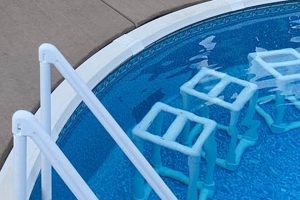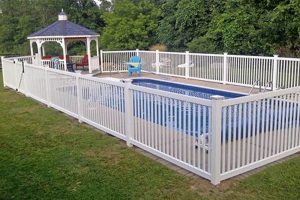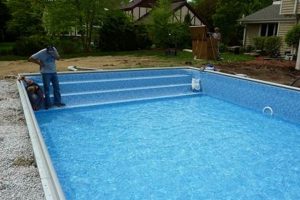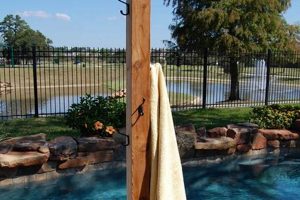A self-constructed cascade feature integrated into a swimming pool provides both aesthetic enhancement and functional aeration. These water features, built by homeowners, range in complexity from simple stacked stone arrangements to more elaborate constructions incorporating pumps, plumbing, and custom-designed spillways. An example involves using readily available materials like landscaping rocks and a submersible pump to create a gentle flow of water into the pool.
The incorporation of such features offers multiple advantages. Beyond visual appeal, the continuous water movement aids in circulation, preventing stagnation and promoting even distribution of pool chemicals. Historically, water features have been used in various cultures to create a sense of tranquility and to manage water flow, mirroring design principles found in ancient Roman baths and Japanese gardens. The benefits include a more enjoyable swimming environment and potentially reduced maintenance requirements.
The following sections will detail the essential elements involved in planning and executing a successful project, covering aspects such as design considerations, material selection, construction techniques, and safety protocols. A thorough understanding of these factors is critical for achieving a visually appealing and functionally sound outcome.
Essential Construction Guidance
The successful implementation of a water feature depends on meticulous planning and precise execution. The following guidelines aim to provide crucial insights into key aspects of construction, ensuring durability and functionality.
Tip 1: Foundation Integrity: Prior to any construction, ensure a stable and level foundation. Uneven surfaces can lead to structural instability and eventual failure. A concrete base, properly reinforced, is recommended for larger, more complex designs.
Tip 2: Hydraulic Calculation: Accurate pump sizing is paramount. Insufficient pump capacity will result in a weak, unattractive water flow. Conversely, an oversized pump wastes energy and can create excessive splashing. Consult hydraulic charts to determine optimal flow rates based on waterfall height and width.
Tip 3: Material Selection: Choose materials resistant to prolonged water exposure and chemical imbalances. Natural stone, treated lumber, and specific types of composite materials are frequently employed. Avoid porous materials prone to erosion and algae growth.
Tip 4: Plumbing Integration: Employ durable, non-corrosive plumbing components. Schedule 40 PVC piping, properly sealed and secured, is standard practice. Ensure adequate pipe diameter to accommodate the designed flow rate, minimizing friction loss.
Tip 5: Filtration Systems: Implement an effective filtration system to maintain water clarity and reduce maintenance requirements. Regularly backwash or clean filters to prevent clogging and ensure optimal performance. Consider integrating a UV sterilizer to inhibit algae growth.
Tip 6: Electrical Safety: All electrical components must adhere to local electrical codes. Utilize a Ground Fault Circuit Interrupter (GFCI) to protect against electrical shock. Employ a licensed electrician to handle all electrical connections, minimizing the risk of hazards.
Tip 7: Waterfall Positioning: Strategically position the feature to maximize aesthetic impact and minimize water loss due to wind and evaporation. Consider the prevailing wind direction when selecting a location. Shielding the waterfall from direct sunlight can also help control algae growth.
Adherence to these guidelines will significantly enhance the longevity, performance, and overall satisfaction derived from the constructed water feature.
The subsequent sections will address potential troubleshooting scenarios and long-term maintenance strategies.
1. Design Conceptualization
Design conceptualization forms the foundational stage for any water feature construction, dictating its aesthetic integration with the surrounding landscape and the functional requirements for water flow and structural stability. A poorly conceived design will inevitably lead to aesthetic disharmony and potentially compromise the structural integrity of the entire assembly.
- Scale and Proportion
The size and dimensions of the waterfall must be in proportion to the swimming pool and its surroundings. A disproportionately large waterfall can overwhelm the space, while one too small may appear insignificant. Considerations include pool size, deck area, and overall landscape design. For instance, a small, informal pool in a natural setting would benefit from a smaller, rock-based waterfall, whereas a larger, more formal pool might accommodate a grander, structured design.
- Material Harmony
The materials used in constructing the feature should complement the existing pool and landscape elements. Employing dissimilar materials can create a jarring aesthetic. Stone, concrete, and landscaping materials should be selected to blend cohesively with the surrounding environment. For example, if the pool deck is constructed from travertine, using similar or complementary stone for the waterfall will create a unified look.
- Water Flow Dynamics
The design must account for water flow patterns and aeration. Considerations include the height of the waterfall, the width of the spillway, and the angle of water impact. Improperly designed water flow can lead to excessive splashing, noise, or inadequate aeration. A design incorporating multiple tiers or spillways can create a more visually appealing and aerating effect.
- Accessibility and Maintenance
The design should incorporate accessibility for maintenance and repairs. The pump, plumbing, and filtration systems should be easily accessible for routine maintenance. Furthermore, the design should minimize areas prone to algae growth and debris accumulation. For instance, designing the waterfall with smooth, easily cleanable surfaces can reduce maintenance efforts.
These facets of design, when carefully considered and implemented, result in a swimming pool water feature that is both aesthetically pleasing and functionally efficient. Neglecting any of these design considerations can lead to long-term maintenance issues, structural instability, and ultimately, a less enjoyable aquatic environment. Design is the blueprint for success of the project.A poorly conceived design is not just an aesthetic issue; it can precipitate functional and structural problems that affect the pool and surrounding environment.
2. Structural Integrity
The structural integrity of any self-constructed swimming pool water feature directly impacts its longevity, safety, and overall performance. The cascade’s ability to withstand constant water flow, varying weather conditions, and potential ground movement hinges on a robust structural design and execution. A failure to adequately address structural considerations can result in collapse, water leakage, or damage to the surrounding pool and landscape. For example, a waterfall constructed without a properly reinforced foundation on unstable soil is susceptible to cracking and shifting, potentially leading to costly repairs and safety hazards.
The causes of structural failure in these features are multifaceted. Inadequate foundation preparation, improper mortar mixing, insufficient reinforcement, and the use of unsuitable materials contribute significantly. Real-world examples demonstrate the repercussions: DIY waterfalls constructed with loosely stacked stones, lacking proper bonding agents, have crumbled under the weight of the water and the effects of freeze-thaw cycles. Conversely, designs incorporating reinforced concrete foundations, appropriately sized rebar, and high-quality bonding agents exhibit significantly improved stability and resistance to environmental stressors. Understanding the practical significance of these construction principles is paramount for preventing structural deficiencies and ensuring the long-term viability of the water feature.
In summation, ensuring structural integrity is not merely an aesthetic consideration but a fundamental requirement for a safe and durable feature. Attention to detail regarding foundation construction, material selection, and reinforcement techniques significantly mitigates the risk of structural failure. Adhering to established engineering principles and consulting with qualified professionals when necessary can further enhance the stability and safety of the construction. This focus on structural integrity ensures the water feature remains an asset to the pool environment for years to come.
3. Hydraulic Performance
Hydraulic performance is a critical determinant of both the visual appeal and the functional effectiveness of any self-constructed swimming pool water feature. Precise control over water flow, pressure, and distribution is essential to achieve the desired aesthetic effect while ensuring adequate water circulation and aeration within the pool. Inadequate hydraulic design can lead to a weak, unappealing flow, excessive splashing, or inefficient water treatment.
- Pump Selection and Sizing
The pump serves as the heart of the hydraulic system, dictating the volume and pressure of water delivered to the feature. Pump selection must align with the waterfall’s height, width, and flow rate requirements. Undersized pumps result in insufficient flow, while oversized pumps waste energy and may create turbulent, undesirable effects. For example, a waterfall spanning 10 feet in width and rising 3 feet above the pool surface necessitates a pump capable of delivering a specific flow rate, typically measured in gallons per minute (GPM), calculated based on hydraulic principles.
- Piping Diameter and Material
The diameter of the piping used to convey water from the pump to the waterfall’s spillway directly influences flow efficiency. Narrow pipes create increased friction, reducing flow rate and increasing energy consumption. Conversely, excessively large pipes may increase cost without providing commensurate performance gains. Schedule 40 PVC pipe is commonly used due to its durability and resistance to chemical degradation. Proper pipe sizing ensures minimal head loss, maximizing the efficiency of the pump.
- Spillway Design and Configuration
The design of the spillway significantly impacts the visual characteristics of the waterfall. A level, uniformly wide spillway produces a smooth, consistent sheet of water, while an uneven or textured spillway creates a more natural, cascading effect. The angle of the spillway also affects the trajectory and sound of the water. Precise engineering of the spillway ensures the desired aesthetic outcome. For instance, a bullnose edge on the spillway can create a cleaner, more defined water curtain.
- Filtration and Water Treatment Integration
The hydraulic system must seamlessly integrate with the pool’s filtration and water treatment processes. A well-designed system ensures that water drawn for the waterfall is adequately filtered and sanitized before being returned to the pool. This prevents debris accumulation within the waterfall and helps maintain overall water quality. Integrating a bypass valve allows for isolating the waterfall during periods of high debris load or maintenance, preventing damage to the pump and plumbing.
In essence, hydraulic performance is not simply about moving water; it encompasses a holistic approach to water management within the swimming pool environment. Optimizing pump selection, pipe sizing, spillway design, and filtration integration ensures a visually stunning, energy-efficient, and environmentally sound self-constructed water feature. Neglecting these hydraulic principles compromises the aesthetic and functional value of the installation and potentially increases long-term maintenance costs.
4. Material Durability
Material durability is a cornerstone of any successful self-constructed swimming pool water feature. The constant exposure to water, pool chemicals, sunlight, and fluctuating temperatures places significant stress on the materials used, making their inherent resistance to degradation paramount. Inadequate material selection inevitably leads to premature deterioration, necessitating costly repairs or complete reconstruction. The cause-and-effect relationship is direct: selecting durable materials ensures longevity; failing to do so guarantees early failure. For instance, using untreated wood in direct contact with chlorinated water will result in rot and structural weakening within a short timeframe, whereas using a treated composite material would significantly extend the structure’s lifespan.
The importance of material durability extends beyond simple longevity. The structural integrity, aesthetic appeal, and safety of the water feature are all directly contingent upon the chosen materials’ ability to withstand environmental stressors. Consider a waterfall built using porous rock susceptible to freeze-thaw cycles. Water penetrates the rock, freezes, expands, and causes cracking. Over time, this process degrades the rock, compromising the waterfall’s stability and potentially creating falling debris hazards. Conversely, selecting dense, non-porous stone minimizes water absorption, significantly reducing the risk of freeze-thaw damage. This underscores the practical significance of choosing materials specifically suited for aquatic environments. Proper material selection prevents not only structural damage but also aesthetic degradation, such as discoloration or algae growth that can detract from the feature’s visual appeal.
In conclusion, the selection of durable materials is an indispensable component of a successful self-constructed swimming pool water feature. While initial cost may be a factor, prioritizing long-term durability over short-term savings is crucial. The increased upfront investment in materials designed to withstand the rigors of the aquatic environment translates to reduced maintenance, enhanced safety, and an extended lifespan for the feature. Recognizing the challenges posed by constant water exposure, chemical interactions, and environmental fluctuations underscores the need for informed material choices, ultimately ensuring a visually appealing and structurally sound addition to the pool area.
5. Electrical Safety
Electrical safety is of paramount importance when constructing a self-installed swimming pool water feature. The proximity of water and electrical components creates a potentially hazardous environment, necessitating strict adherence to safety protocols and regulatory guidelines. Failure to prioritize electrical safety can result in severe injury or fatality.
- Ground Fault Circuit Interrupters (GFCIs)
GFCIs are essential protective devices designed to detect even minute electrical current leakage to ground. These devices interrupt the circuit within milliseconds, preventing potentially fatal electrical shocks. All electrical outlets and equipment within a specified distance of the pool, typically 10-20 feet, must be GFCI protected. An example involves a submersible pump used to power the water feature; its electrical cord must be plugged into a GFCI-protected outlet to mitigate the risk of electrocution should a fault occur within the pump.
- Bonding and Grounding
Bonding involves connecting all metallic components within and around the pool, including the reinforcing steel in the pool shell, metal fencing, and the waterfall structure, to create a common electrical potential. Grounding connects this bonded system to earth, providing a path for fault currents to flow back to the electrical source, tripping the circuit breaker. Proper bonding and grounding minimize the risk of voltage differences between metallic surfaces, preventing electrical shock. For example, if the metal frame of the waterfall is not properly bonded, it could become energized due to a fault, posing a significant hazard to anyone in contact with the water.
- Wiring and Conduit
All wiring supplying power to the water feature must be appropriately sized, insulated, and installed within approved conduits. Underground wiring must be buried at a sufficient depth to prevent damage from digging or ground movement. Conduit protects the wiring from physical damage and moisture, reducing the risk of short circuits or ground faults. An example includes using rigid PVC conduit to encase the wiring running from the house to the pump, protecting it from exposure to soil moisture and physical abrasion.
- Professional Installation and Inspection
Given the inherent risks associated with electricity and water, engaging a qualified and licensed electrician is crucial for all electrical work related to the water feature. A professional can ensure compliance with local electrical codes, proper installation of GFCIs, bonding and grounding systems, and safe wiring practices. A post-installation inspection by the electrician is also recommended to verify the system’s integrity and safety. DIY electrical work can lead to dangerous and potentially lethal outcomes, highlighting the importance of entrusting these tasks to trained professionals.
These facets of electrical safety are not discretionary; they are essential safeguards that mitigate the inherent risks associated with combining water and electricity in a swimming pool environment. Strict adherence to these protocols is not merely a matter of compliance but a moral imperative to protect the safety of swimmers and anyone interacting with the water feature. Neglecting these precautions can have devastating consequences.
Frequently Asked Questions
This section addresses common inquiries regarding the planning, construction, and maintenance of self-constructed swimming pool water features. The information provided aims to clarify misconceptions and offer practical guidance based on established engineering principles and safety standards.
Question 1: Is a building permit required for the construction of a DIY swimming pool waterfall?
The necessity of a building permit varies based on local regulations and the scale of the project. Structures exceeding a certain height or involving significant plumbing or electrical modifications typically necessitate permits. Contacting the local building department is crucial to ascertain specific requirements and avoid potential fines or legal complications.
Question 2: What is the recommended distance between the waterfall and the pool’s edge?
The optimal distance depends on design preferences and desired functionality. Placing the waterfall too close may result in excessive splashing and erosion of the surrounding area. Conversely, positioning it too far can diminish the visual impact. A distance of 2-4 feet from the pool’s edge is generally considered a suitable compromise, allowing for adequate water flow and minimal splash-out.
Question 3: What type of pump is most suitable for a swimming pool waterfall?
The selection of an appropriate pump is contingent upon the desired flow rate, waterfall height, and piping configuration. Submersible pumps are often favored for smaller installations due to their ease of installation and quiet operation. External pumps offer greater power and are more suitable for larger, more elaborate water features. Consulting hydraulic charts and considering the total dynamic head (TDH) is essential for proper pump sizing.
Question 4: How can algae growth on the waterfall be prevented?
Algae growth is a common challenge in aquatic environments. Implementing a multifaceted approach is recommended. This includes maintaining proper pool water chemistry, ensuring adequate water circulation, utilizing UV sterilizers to inhibit algae proliferation, and periodically cleaning the waterfall structure with a mild algaecide solution. Selecting materials resistant to algae growth can also mitigate the problem.
Question 5: What is the recommended maintenance schedule for a DIY swimming pool waterfall?
Regular maintenance is crucial for preserving the aesthetic appeal and functional performance of the water feature. A weekly inspection to remove debris and check water chemistry is advisable. Monthly cleaning of the pump filter and waterfall structure is recommended. Annual inspection of all plumbing and electrical connections is essential to identify and address potential issues before they escalate.
Question 6: Can the waterfall be integrated with the pool’s existing filtration system?
Integration with the pool’s filtration system is possible, provided the system’s capacity is adequate to handle the additional water flow. However, dedicating a separate filtration system specifically for the waterfall is generally recommended. This prevents debris from the waterfall from overburdening the pool’s primary filtration system and ensures optimal water clarity in both the pool and the waterfall.
In summary, successful construction and maintenance of a self-constructed swimming pool waterfall require careful planning, adherence to safety protocols, and a thorough understanding of hydraulic principles and material properties. These FAQs provide a foundation for informed decision-making and responsible project execution.
The following section will delve into advanced troubleshooting strategies for common waterfall-related issues.
DIY Swimming Pool Waterfall
This exploration has addressed critical considerations for incorporating a self-constructed water feature into a swimming pool environment. From initial design conceptualization and structural stabilization to hydraulic performance optimization, material selection for endurance, and essential electrical safety protocols, the multifaceted nature of these projects demands meticulous attention. Diligence in adhering to regulatory standards, combined with a thorough understanding of engineering principles, forms the bedrock of a successful and safe installation.
The information presented underscores the significance of informed decision-making in all phases of waterfall construction. Prioritizing safety, structural integrity, and long-term performance over short-term cost savings remains paramount. Prospective builders are encouraged to seek professional consultation when necessary, ensuring the realization of a visually appealing and functionally sound addition to their aquatic environment. The ultimate success of a project hinges on a commitment to responsible construction practices and ongoing maintenance protocols, safeguarding both the investment and the well-being of all users.







